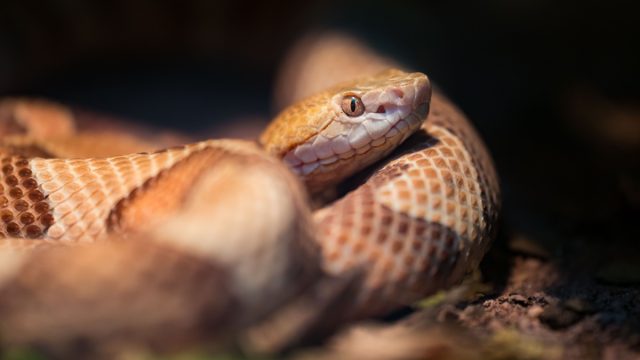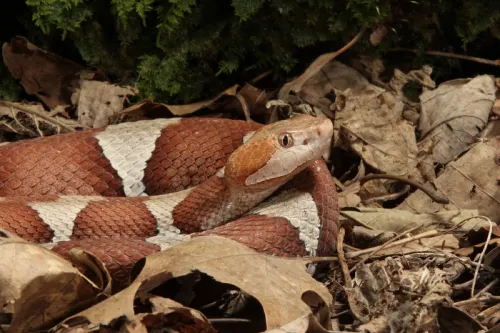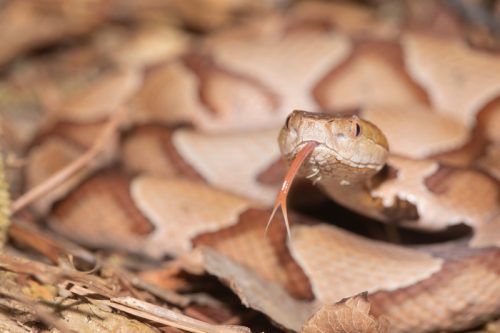A Deadly Snake Bit a 5-Year-Old at His Home—Here’s Where It Was Hiding

You’d be hard-pressed to think of anything you’d rather encounter less in your home than a venomous snake. Unfortunately, these creepy creatures might be attracted to your yard by something as simple as mulch, and they can sneak their way into your house any number of ways—even through your toilet. According to experts, there are more than 30 species of venomous snakes roaming around the country. Recently, a 5-year-old child faced grave danger when he encountered a copperhead snake in his own home. Read on to find out where the snake was hiding, and how you can avoid a run-in.
READ THIS NEXT: If You Live Here, Watch Out for This Venomous Snake in Your Backyard.
A young boy was just bitten by a deadly snake at his Texas home.

On June 1, an “unsuspecting” 5-year-old boy named Daniel was bitten by a copperhead snake at his home in Texas, the Fort Worth Star-Telegram recently reported. Copperhead snakes are one of the most commonly seen snakes in the U.S., and they’re also “the most likely to bite,” Live Science explains. This snake belongs to the pit viper family: These venomous snakes that have “heat-sensory pits between eye and nostril on each side of head” that aide them in accurately striking potential prey.
According to the newspaper, Daniel was rushed to an emergency room in Houston after the snake bit him and injected venom into his hand. In a viral June 2 Facebook post, Brandy Madrid Smith, the child’s aunt, wrote that he was treated by toxicologist Spencer Greene, MD. “I’ve truly never been so scared in my life,” Smith wrote, adding that she was “so thankful” for Greene and the other healthcare professionals because Daniel was able to go home the day after his attack after being treated with six vials of antivenom.
Copperhead snakes are easily able to hide out of sight.

Daniel was picking up leaves outside his home with his uncle when he accidentally grabbed the copperhead snake that attacked him, according to the Fort Worth Star-Telegram. It’s likely that the 5-year-old boy did not even see the snake before he picked it up. On its website, the Texas Parks and Wildlife Department explains that a copperhead snake’s gray and brown bands, as well as its copper-colored head, allow it to easily blend in with fallen leaves on the ground—so easily, in fact, that “it’s possible to stare right at a copperhead without seeing it,” the experts say.
“Because they are so well-camouflaged, most bites occur when a snake is accidentally picked up or sat or laid on,” the department says. “Always use care when picking up or flipping over logs, boards, old tin or other items where copperheads may be resting.”
RELATED: For more up-to-date information, sign up for our daily newsletter.
This snake’s venom may be more harmful to certain people.

Copperhead snakes have hemotoxic venom, Jeff Beane, a herpetologist and collections manager of amphibians and reptiles at the North Carolina Museum of Natural Sciences, told Live Science. This means that a bite from the snake “often results in temporary tissue damage in the immediate area of bite,” according to Beane.
“Unlike most venomous snakes, copperheads give no warning signs and strike almost immediately if they feel threatened,” he told Live Science.
On a positive note, the venom from a copperhead snake is a lot less potent than that of other venomous snakes, according to National Geographic. While their bite is likely to be painful, it is “very rarely (almost never) fatal to humans,” Beane said. You should still be cautious around copperhead snakes, of course, and you will need medical attention if bitten by one. Some people in more vulnerable groups can have especially strong reactions to the venom, including children like Daniel, the elderly, and immunocompromised people.
There are certain things you should do if you’re bitten by a snake.

Around 7,000 to 8,000 people are bitten by venomous snakes in the U.S. each year, according to the National Institute for Occupational Safety and Health (NIOSH). While only about five of those people end up dying, the agency warns that the “number of deaths would be much higher if people did not seek medical care.”
In her Facebook post, Smith offered up tips she had been given by Greene on how to respond to a snake bite. According to the toxicologist, there are a number of things you should not do if bitten—even though they might seem like helpful actions. This includes not cutting or draining the affected area, not putting a tourniquet on it, and not putting ice on a snake bite, as this “actually does more damage to the tissue.” Instead, Greene advised Smith that you should immediately be elevating the area to 60 degrees, as “you want the venom to dissipate as quickly as possible.”
READ THIS NEXT: The No. 1 Place Snakes Love to Hide in Your Home.